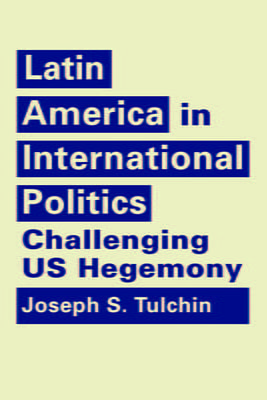A Review of Latin America in International Politics: Challenging US Hegemony
Latin American Foreign Policy: How Much Choice?
A review by Christopher Sabatini

Latin America in International Politics: Challenging US Hegemony by Joseph S. Tulchin, (Lynne Rienner Publishers, 2016, 235 pages)
U.S. studies of the international relations of Latin American states and inter-American foreign policy have traditionally been viewed (stuck even) through the prism of U.S. hegemony, in large part for good reason. Since the 1823 Monroe Doctrine, the United States treated the hemisphere as its special prerogative. As the overwhelming economic, military and political power, the Colossus to the North became the central factor shaping how Latin America and Caribbean states identified and asserted their national interests in foreign policy.
That scholarly approach to the international rela tions of Latin America and the Caribbean—while largely justifiable—precluded the development of more granular, comparative U.S. scholarship on the foreign policymaking processes and institutions in the region. Fortunately, as the shadow of U.S. power has waned in the hemisphere, the field has enjoyed somewhat of a boom. From single country case studies (such as Aspirational Power by Mares and Trinkunas on Brazil) to edited volumes on regional multilateralism (such as Pia Riggirozzi, and Diana Tussie’s The Rise of Post-Hegemonic Regionalism: The Case of Latin America ) to analyses of remerging extra- hemispheric powers’ role in the region (such as Kevin Gallagher’s The Dragon in the Room: China and the Future of Latin American Industrialization and R. Evan Ellis’s China in Latin America: The Whats and Wherefores), academics, think tankers and policy analysts are turning their attention to the evolving dynamic of international and global relations in the hemisphere.
To this much-welcome flurry of research and publication, former director of the Latin American Program at the Woodrow Wilson International Center for Scholars, Joseph Tulchin has added his historical perspective. His book, Latin America in International Politics: Challenging US Hegemony, is an erudite, nuanced and sweeping view of the evolution of Latin American foreign policies in the context of U.S. power from independence to the present.
The focus of Tulchin’s readable, well-researched, and ambitious book is the expanding space for Latin American states to determine their national interests on their own and pursue them in their foreign policies—to use the social science terminology and the word Tulchin uses frequently, their “agency” in foreign policy. As he writes, “The relative absence of agency in Latin America and the process by which agency grows and evolves in different countries is the central thread of this book’s narrative” (p. 8).
In discussing and summarizing the history of foreign policy formation and implementation in the region, Tulchin’s training and approach as a historian really bears fruit. Indeed, much of the book—158 pages of the 191-page book—is dedicated to the history of foreign policymaking in the region, with only the final chapter focusing on modern- day agency after hegemony. Unfortunately, the later section is where the book tends to stray off and lose its focus, ultimately failing to deliver what the author promises in the first chapter: a more current, systematic analysis of how Latin American states have gained and are using their agency and its limits.
But what a great, original, insightful read it is until then. The author’s strength is in tracing the history of the interplay between domestic concerns (such as state building in the early 19th century and later authoritarian ambitions and democratic pressures) and foreign policy, within and outside U.S. influence. Tulchin artfully laces together international theory and history, with themes of nation building, elite worldviews, institutional capacity, and anecdotes and insights. Rather than plodding through his argument chronologically, Tulchin skips back and forth in time to make larger arguments about the creation of an international community based on Western European-style rule of law, the interactions of elites and egos, national geopolitical ambitions, the development of scholar/practitioner networks on foreign policy, and efforts at regional integration. The structure makes the book all the more readable and powerful theoretically. All the while, Tulchin peppers his sweeping historical theory building with stories about the personalities involved and rare details such as quotes from memos and cables and inside conversations, clearly drawing from his own extensive research and (from the 1970s on) personal contacts and conversations with many of the central players. The result is a long overdue and original book on the history of international relations that stands atop the older literature (and some contemporary arguments as well) that have focused almost obsessively on U.S. hegemony and its negative consequences.
When discussing the present state of foreign policymaking in the region, though, the analysis trails off. The final chapter, in which Tulchin explores the scope for agency in contemporary hemispheric international relations, feels rushed. In the broad effort to tie together his excellent historical analysis to recent developments in 32 pages, the chapter loses its systematic approach, becomes repetitive, at times contradictory, and often lapses into unexplained generalities and platitudes. The result for the reader is the sense that there’s a larger, important argument being made here that just keeps slipping through her fingers. For one, in the quest to uncover and detail agency in current hemispheric policymaking, Tulchin abandons structure. Because he desires to avoid ascribing everything to structure, Tulchin leaves aside the new (and old) global and regional structural factors that shape—and will continue to shape—foreign policymaking in the region. Issues such as the rise of commodity prices that empowered countries like Brazil and Venezuela economically and diplomatically, the rise of China and with it emerging global multipolarity, and the declining relative power of the United States and its economy are given short shrift. The chapter and Tulchin’s argument could have been better served if these global and regional structural factors had been presented earlier, since they explain largely the extent of autonomy individual states enjoy in the region and the broader global context in which they define and pursue their agendas today. Instead, Tulchin takes us through a tour of individual countries’ foreign policies, leaving some out, often diverging on several tangents (such as his discussions on human rights in Argentina), and never attempting across the countries to examine factors such as endowments, interests, ideology and state foreign policymaking capacity (say, Chile versus Bolivia)—a rigor that would give us some broad comparative insight into foreign policymaking today.
Other issues are not given sufficient attention. Trade and the importance of business relations are only mentioned at the end and never as a driving factor in this new era of regional relations, when arguably—as with the commodities boom— they have played (and will continue to play) an important role in shaping foreign policies in the region. Pacific Alliance and the Trans-Pacific Partnership (TPP) are only given passing attention. Rather than describing the broader economic forces at play (some of them driven by large business interests, the so-called multi-latinas in these countries) Tulchin pays greater relative attention to the multilateral diplomatic bodies of UNASUR and CELAC. But in those cases, the author can’t seem to make up his mind whether they will become important institutions or not. He also fails to mention how the emerging regional muscularity will affect drug policy, though he analyzes the issue in depth in previous chapters.
In the author’s ambition to bring together all the potential changes, the final chapter also has a tendency to make assertions that leave the reader wanting more. Lines like, “the double revolution—globalization and the transition to democracy—established the conditions for policymaking process…” (p.162) or, when discussing the growth of a community of non-state networks, “Throughout the community, globalization brought dramatic increases in the diffusion of services, products and ideas” (p. 165) are left without much explanation or analysis of how they have concretely affected policymaking. In the book’s previous chapters similar factors would have received fuller attention in terms of examples and detail.
In some cases, the failure to back up specific assertions leads to later contradictions or curious claims. Such is the case when, on p. 187, Tulchin says that Latin American governments’ “membership in international regimes today gives them opportunities to discuss the rules that govern exchange.” This comes in the same chapter in which Tulchin discusses the failure to fully reform the Bretton Woods system, the emptiness of the Brazil, Russia, India, China and South Africa (BRICS) alliance, and the region’s lack of voice over critical votes in the UN on Syria or Libya—leading the reader to wonder exactly what institutions and what rules he means. Similarly, the argument in the latter pages of the book that Cuba “continues to represent successful agency in a changing world” is belied by the country’s dependence on Venezuelan oil and crumbling economy. Tulchin cites examples of recognition of Cuba’s role in areas like health, but those are hardly consistent with the sort of real agency as he defines it earlier, and later adds vaguely “that may change in the next few years” (p. 190).
The book’s analysis of current affairs and its attempt to build a new theory to encompass foreign policy in the hemisphere today suffers from the near complete absence of recent scholars and literature that have covered the same questions Tulchin has set out to answer. There has been a wealth of new monographs, articles and books by a new generation of academics and think tank scholars such as Jorge Garzón Pereira, Andrés Malamud, Ted Piccone, Julio César Cassio Rodríguez, Sören Scholvin, Matias Spektor, Oliver Stuenkel and Harold Trinkunas that have examined the new foreign policies in the region, the geopolitics of Brazil’s rise, and the evolution of regional multilateral organizations in Latin America that Tulchin appears either to not be aware of or to have ignored (though he cites nine past works of his own). It’s a shame, because the author/historian could have used this opportunity to bridge his experience and long view with this exciting new body of recent theory building.
At the end of the book, Tulchin turns to asking a series of questions. Among those: will “The nations of Latin America be prepared to expand their agency? Do they want to?” (p. 191). To be honest, I found myself wishing he would have at least helped me shape the answers to those questions. But the author hasn’t sufficiently analyzed the structural or institutional context today that will shape those decisions. Focusing too much on agency, he makes it sound—throughout the final chapter and in these questions—as if it were within these states’ sole power to set these courses. The shift is odd, since, in Tulchin’s excellent previous chapters, he never would have framed the question the same way: as one only of agency. This lack of rigorous follow-through in the final chapter ultimately leaves the matter of how and what has and will shape the agency of Latin American states today and in the future unanswered.
Christopher Sabatini is a lecturer of international and public policy at Columbia University’s School of International and Public Affairs (SIPA) and executive director of Global Americans and editor of its website: www.LatinAmericaGoes-Global.org You can follow him on Twitter @ChrisSabatini
Related Articles
A Review of San Fernando: Última Parada, Viaje al crimen autorizado en Tamaulipas
One of Mexico’s best investigative journalists, Marcela Turati, takes readers to terrorized and traumatized San Fernando, a town known for dozens of mass graves, and exposes the depths of criminal brutality and official corruption that hid the bodies and the truth for years.
A Review of Until I Find You: Disappeared Children and Coercive Adoptions in Guatemala
A student in my “Introduction to Cultural Anthropology” course at the University of Delaware approached me several weeks ago, after hearing about my long-term research in Guatemalan communities, to tell me that they were born there, in Guatemala.
A Review of Default: The Landmark Court Battle over Argentina’s $100 Billion Debt Restructuring
In February 2019, I found myself serving as the special attorney general for the then newly recognized interim government of Venezuela, tasked with addressing more than 50 claims before the U.S. courts stemming from the $140 billion debt inherited from Hugo Chávez and Nicolás Maduro.




